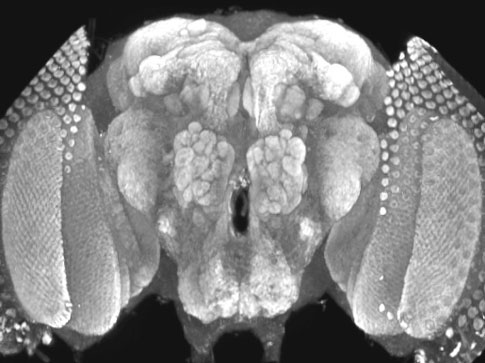|

| |
 Cynthia
Barber, 2004- Cynthia
Barber, 2004-
B.S. in Mol./Cellular/Dev. Biology; Mathematics; Biochemistry at the Univ. of
Colorado, 2003
Cindy
characterized the regulation of Synaptotagmin 4 function at the Drosophila
NMJ. Axonal sprouting and synaptic rewiring are key regulators of neuronal
plasticity in the developing brain. Similar to many species, modulation of
synapse formation in Drosophila has been implicated in learning and
memory. Synapse formation requires coordinated signaling to orchestrate pre- and
post-synaptic maturation of synaptic connections. Although communication from
the presynaptic neuron via Ca++-dependent synaptic vesicle fusion has
been well characterized, the molecular mechanisms that allow postsynaptic
targets to transmit retrograde signals are relatively unknown. Indeed, it is
still unclear if postsynaptic Ca++ signals can trigger dendritic
release of signaling molecules across the synapse. Recently, the lab has
localized a member of the Drosophila Synaptotagmin Ca++ sensor
family (Syt 4) to the postsynaptic terminal at neuromuscular junctions (Adolfsen,
2004). The best-characterized member of the family, Syt 1, localizes to
synaptic vesicles in the presynaptic terminal and acts as a Ca++
sensor for fast synchronous fusion. The localization of Syt 4 to the
postsynaptic terminal suggests a potential role in coupling postsynaptic Ca++
influx to retrograde signaling across the synapse. Further support for Syt
4-mediated retrograde signaling comes from analysis of the Drosophila syt 4
null mutant, where early synapse formation is abnormal and high frequency
dependent potentiation of the embryonic synapse is defective (Yoshihara et al.,
2005). To further characterize the role of Syt 4 in retrograde signaling, Cindy
has begun to investigate the regulation of Syt 4 function in the postsynaptic
compartment. The mammalian Syt 4 homolog has been previously identified as an
activity-regulated intermediate early gene. To test whether this regulation of
Syt 4 expression is evolutionarily conserved, Cindy investigated the
relationship between neuronal activity and Syt 4 expression in a host of
Drosophila temperature-sensitive activity mutants. Lines that exhibit even
a modest depression of basal synaptic activity at room temperature express lower
levels of Syt 4 protein, while episodic temperature induction of paralysis in
these same lines do not alter protein levels. We have generated transgenic flies
expressing Syt 4-promoter fusions to GFP to determine if this regulation occurs
at the transcriptional or post-transcriptional level. Additionally,
Drosophila lines with altered Syt 4 expression are being examined for
changes in synaptic function to determine the consequences of altered Syt 4
levels on synaptic transmission. These findings indicate that activity-regulated
expression of the Syt 4 protein may be a conserved mechanism for modulation of
synaptic function.
|




